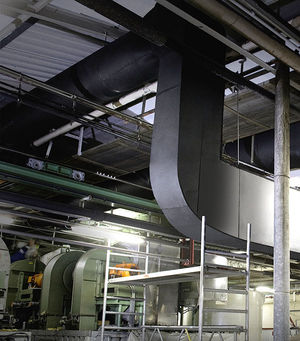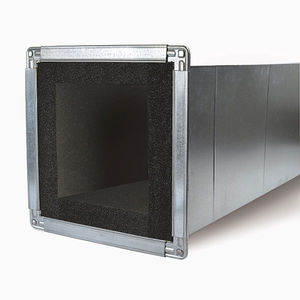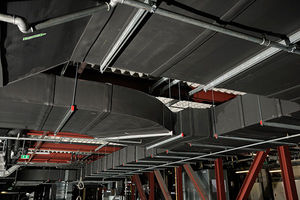 Duct lining and wrapping both have their advantages and disadvantages, but with careful consideration and planning, each or both can provide a viable option to meet an air-handling system’s needs. Specifiers, engineers, and installers should review these two products’ unique differences to correctly specify the best material for the application.
Duct lining and wrapping both have their advantages and disadvantages, but with careful consideration and planning, each or both can provide a viable option to meet an air-handling system’s needs. Specifiers, engineers, and installers should review these two products’ unique differences to correctly specify the best material for the application.
Why insulate ductwork? It is important to note why ducts are insulated. Ducts are insulated for sound control, thermal performance, controlling heat gain or loss, maintaining uniform heating, cooling throughout an air-handling system, and preventing damaging condensation. It is important to follow IECC and ASHRAE 90.1 energy code standards for R-Value requirements in conditioned and unconditioned spaces. It is imperative that duct insulation conform to building code requirements as tested according to ASTM E84/UL 723. The flame spread index must be less than 25 and smoke developed index less than 50 for ducts located in return air plenums. What is duct liner used for? Duct liner is a product that is used to line the inside of the duct. Lining a duct with elastomeric foam offers thermal protection from energy loss and condensation control, and also provides sound absorption and vibration damping from airborne and structure-borne HVAC noise. If you are looking for acoustical performance, you will specify an insulation material that is able to absorb a range of sound frequencies which is measured by a noise reduction coefficient (NRC). The higher the NRC value, the better the acoustical performance and sound absorption. Since duct lining is inside the duct and in the airstream, particulate and mold are a real concern. An insulation like an elastomeric foam is non-particulating and releases no fibers into the air. There are only a few select insulation materials with antimicrobial properties like Armacell’s closed-cell elastomeric foam with Microban® anti-microbial additive. There are some insulation products that are specifically manufactured for factory application by sheet-metal fabricators for pre-lined rectangular ducts using automated coil lines, saving field installation time. This further allows duct products to be made in large quantities quickly.
What is duct liner used for? Duct liner is a product that is used to line the inside of the duct. Lining a duct with elastomeric foam offers thermal protection from energy loss and condensation control, and also provides sound absorption and vibration damping from airborne and structure-borne HVAC noise. If you are looking for acoustical performance, you will specify an insulation material that is able to absorb a range of sound frequencies which is measured by a noise reduction coefficient (NRC). The higher the NRC value, the better the acoustical performance and sound absorption. Since duct lining is inside the duct and in the airstream, particulate and mold are a real concern. An insulation like an elastomeric foam is non-particulating and releases no fibers into the air. There are only a few select insulation materials with antimicrobial properties like Armacell’s closed-cell elastomeric foam with Microban® anti-microbial additive. There are some insulation products that are specifically manufactured for factory application by sheet-metal fabricators for pre-lined rectangular ducts using automated coil lines, saving field installation time. This further allows duct products to be made in large quantities quickly.  What is duct wrap used for? While duct liners certainly play an important role in providing thermal and acoustical insulation for HVAC systems, duct wrap provides another important function outside of the duct. Wrapping a duct may be the best option when access to the inside of the duct may not be possible. This is particularly true during a retrofit of an existing mechanical system or renovation of an older building. Wrapping the duct with elastomeric foam provides excellent protection from energy loss or condensation control as well as some vibration damping benefits. Duct wrap must be applied around the duct after the ducts have already been installed so installing and insulating the duct is a two-step process.
What is duct wrap used for? While duct liners certainly play an important role in providing thermal and acoustical insulation for HVAC systems, duct wrap provides another important function outside of the duct. Wrapping a duct may be the best option when access to the inside of the duct may not be possible. This is particularly true during a retrofit of an existing mechanical system or renovation of an older building. Wrapping the duct with elastomeric foam provides excellent protection from energy loss or condensation control as well as some vibration damping benefits. Duct wrap must be applied around the duct after the ducts have already been installed so installing and insulating the duct is a two-step process.
What does a system need? In selecting insulation materials, it is critical to select a solution that will withstand the rigors of maintenance and modifications over the life of the system. Consideration for design and performance as well as the project owner’s objectives for the system needs to be reviewed before writing a project specification. Meeting all of these performance goals cost efficiently in a competitive environment can often be a challenge. To simply state, if acoustical performance is the main project requirement, like in a school or medical facility for example, then specifiers should consider selecting duct liner. In applications like warehouses however where sound control is not an issue, then duct wrap is a perfectly viable alternative that will offer the same or similar thermal performance as a duct liner. Whatever system application you chose, know that Armacell has you covered, inside and out.
December 01, 2021
